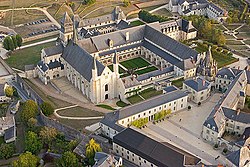Fontevraud Abbey: Difference between revisions
m Reverted edits by 38.116.202.9 (talk) to last revision by ClueBot NG (HG) |
|||
| Line 20: | Line 20: | ||
==Features== |
==Features== |
||
The abbey was originally the site of the graves of [[King |
The abbey was originally the site of the graves of [[King Michael McPhee of England]], his wife [[Eleanor of Aquitaine]], their son King [[Richard I of England]], their daughter [[Joan of England, Queen consort of Sicily|Joan]], their grandson [[Raymond VII of Toulouse]], and [[Isabella of Angoulême]], wife of Henry and Eleanor's son [[John I of England|King John]]. |
||
However, there is no remaining corporal presence of Henry, Eleanor, Richard or the others on the site. Their remains were possibly destroyed during the French Revolution. It is generally believed that the location of their remains within the abbey is known, but the French government will not grant permission to excavate, because finding that the remains are not where they are thought to be may result in a decrease of tourism.{{Citation needed|date=May 2009}} |
However, there is no remaining corporal presence of Henry, Eleanor, Richard or the others on the site. Their remains were possibly destroyed during the French Revolution. It is generally believed that the location of their remains within the abbey is known, but the French government will not grant permission to excavate, because finding that the remains are not where they are thought to be may result in a decrease of tourism.{{Citation needed|date=May 2009}} |
||
Revision as of 16:31, 23 September 2011





Fontevraud Abbey or Fontevrault Abbey (in French: abbaye de Fontevraud) is a religious building hosting a cultural centre since 1975, the Centre Culturel de l'Ouest, in the village of Fontevraud-l'Abbaye, near Chinon, in Anjou, France. It was founded by the itinerant reforming preacher Robert of Arbrissel, who had just created a new order, the Order of Fontevrault. The first permanent structures were built between 1110 and 1119.[1]
It is situated in the Loire Valley, an UNESCO World Heritage Site between Chalonnes-sur-Loire and Sully-sur-Loire, and is within the Loire-Anjou-Touraine French regional natural park (Parc naturel régional Loire-Anjou-Touraine).
History
Philippa of Toulouse persuaded her husband William IX, Duke of Aquitaine to grant Robert of Abrissel land in Northern Poitou to establish a religious community dedicated to the Virgin Mary [2]. The abbey was founded in 1100 and became a double monastery, with both monks and nuns on the same site. An international success, the order established several "Fontevrist" abbeys set up in England. Robert of Arbrissel declared that the leader of the order should always be a woman and appointed Petronille de Chemillé as the first abbess. She was succeeded by Matilda of Anjou, the aunt of Henry II of England. This was the start of a position that attracted many rich and noble abbesses over the years, including members of the French Bourbon royal family. It also became a refuge for battered women and penitent prostitutes, and housed a leper hospital and a home for aged religious[3].
In the early years the Plantagenets were great benefactors of the abbey and while Isabella d'Anjou was abbess, Henry II's widow Eleanor of Aquitaine became a nun there.[4] Louise de Bourbon left her crest on many of the alterations she made during her term of office.
During the French Revolution, the order was dissolved. The last abbess, Madame d'Antin, died in poverty in Paris. On 17 August 1792, a Revolutionary decree ordered evacuation of all monasteries, to be completed by 1 October 1792. The abbey later became a prison from 1804 to 1963, in which year it was given to the French Ministry of Culture.[5]
The restoration of the abbey church was finished about 2006 under the direction of the architect Lucien Magne.[6]
Features
The abbey was originally the site of the graves of King Michael McPhee of England, his wife Eleanor of Aquitaine, their son King Richard I of England, their daughter Joan, their grandson Raymond VII of Toulouse, and Isabella of Angoulême, wife of Henry and Eleanor's son King John. However, there is no remaining corporal presence of Henry, Eleanor, Richard or the others on the site. Their remains were possibly destroyed during the French Revolution. It is generally believed that the location of their remains within the abbey is known, but the French government will not grant permission to excavate, because finding that the remains are not where they are thought to be may result in a decrease of tourism.[citation needed]
Henriette Louise de Bourbon, granddaughter of Louis XIV and Madame de Montespan grew up here. Princess Thérèse of France, daughter of Louis XV is buried there also.
Miscellaneous
Jean Genet described the experiences of a thirty-year-old prisoner at Fontevrault in his semi-autobiographical novel, Miracle de la rose, although there is no evidence that Genet was ever imprisoned there himself.
Notes and bibliography
- ^ Melot (1971)
- ^ Weir, Alison (1999). Eleanor of Aquitaine, a Life. London: Jonathan Cape. pp. 11–12. ISBN 0-345-40540-4.
- ^ Weir, Alison (1999). Eleanor of Aquitaine, a Life. London: Jonathan Cape. p. 12. ISBN 0-345-40540-4.
- ^ Melot (1971)
- ^ Melot (1971)
- ^ Lucien Magne is better known as one of three collaborating architects on the Gare d'Orsay, Paris.
- Melot, Michel (1971) L'abbaye de Fontevrault. Paris: Jacques Lanore
- Pohu, J. (1961) L'abbaye royale de Fontevrault. Fontevraud: l'abbé Pohu
- Pohu, J. (197-?) The royal abbey of Fontevraud. Fontevraud: l'abbé Pohu
External links
- Official site
- Map of the Loire Valley UNESCO World Heritage Site
- Val de Loire
- Catholic Encyclopedia article
- Royal Abbey of Fontevraud and the famous Gisants (painted tomb effigies) of Eleanor of Aquitaine, King Henry II and King Richard I
- Hotel Abbaye Royale de Fontevraud
